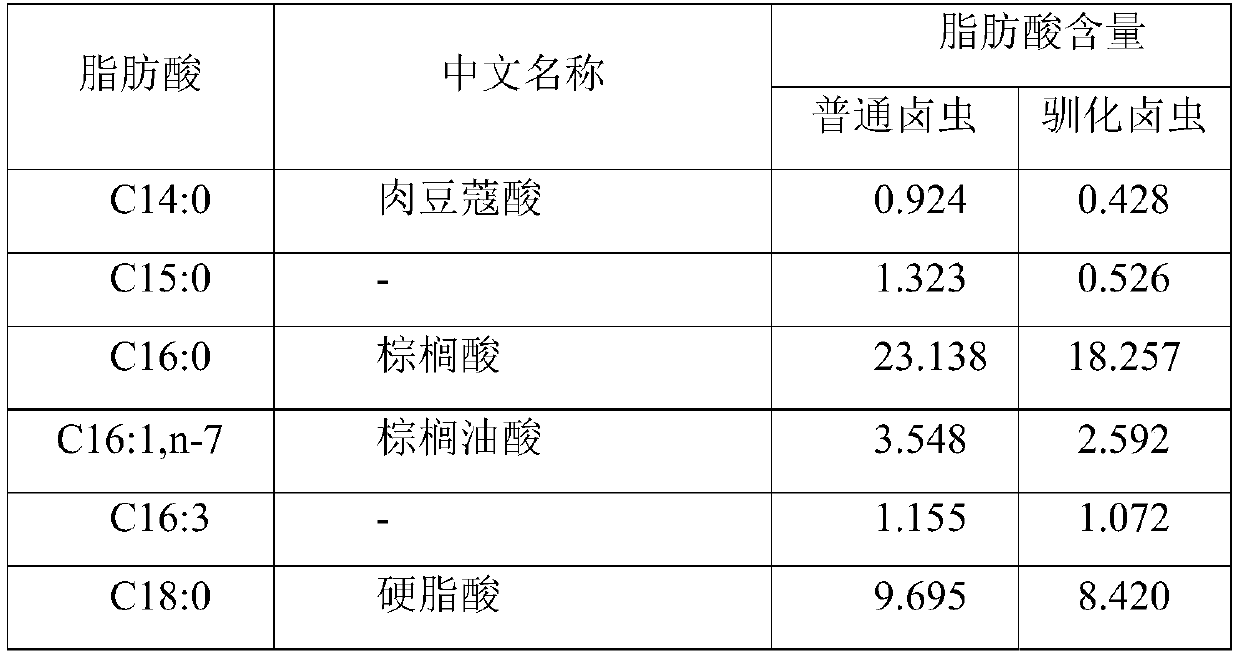Rapidly proliferated brine shrimp in high-temperature and high-salinity environments and domestication method thereof
A high-temperature, high-salt, and environmental technology, applied in the field of aquaculture, to achieve the effects of enhancing fluidity, strengthening endogenous antioxidant capacity, and reducing material costs
- Summary
- Abstract
- Description
- Claims
- Application Information
AI Technical Summary
Problems solved by technology
Method used
Image
Examples
Embodiment 1
[0023] Example 1: Rapidly multiplying Artemia domesticated in a high-temperature and high-salt environment
[0024] (1) Indoor domestication:
[0025] Phase I: To the sterilized area of 200m 2 Inject the filtered water with a depth of 80cm into the indoor pond, adjust the salinity of the water to 3°Bé (30‰, about 30g / L brine salinity), and then insert the hatched artemia with a fresh weight of about 3Kg. Larvae, the control water temperature is 28 ℃, every day divides twice in the pond and sprays and feeds the compound bait A of 20g; 2 ratio mixed to get.
[0026] Phase II: After 5 days of cultivation in Phase I, adjust the salinity of the pool water to 9°Bé (90‰, about 90g / L brine salinity), continue to control the water temperature to 28°C, and increase the daily feeding amount of bait A to 60g.
[0027] Stage III: After 6 days of stage II culture, continue to adjust the salinity of the pool water to 13°Bé (140‰, about 140g / L brine salinity), change the temperature of ...
Embodiment 2
[0032] Example 2: Rapidly multiplying Artemia domesticated in a high-temperature and high-salt environment
[0033] Different from Example 1,
[0034] (1) Indoor domestication:
[0035] Phase I: To the sterilized area of 200m 2 Inject filtered water with a depth of 80cm into the indoor pond, adjust the salinity of the water to 4°Bé (40‰, about 40g / L brine salinity), and then insert the hatched artemia with a fresh weight of about 5Kg. Larvae, the control water temperature is 30 ℃, every day divides twice in the pond and sprays and feeds the compound bait A of 50g; 3 ratio mixed to get.
[0036] Phase II: After 6 days of cultivation in Phase I, adjust the salinity of the pool water to 10°Bé (100‰, about 100g / L brine salinity), continue to control the water temperature to 30°C, and increase the daily feeding amount of bait A to 100g.
[0037] Stage III: After stage II cultivation for 5 days, continue to adjust the salinity of the pool water to 14°Bé (150‰, about 150g / L br...
Embodiment 3
[0041] Example 3: Rapidly multiplying Artemia domesticated in a high-temperature and high-salt environment
[0042] Different from Example 1,
[0043] (1) Indoor domestication:
[0044] Phase I: To the sterilized area of 200m 2 Inject the filtered water with a depth of 90cm into the indoor pond, adjust the salinity of the water to 3°Bé (30‰, about 30g / L brine salinity), and then insert the hatched artemia with a fresh weight of about 5Kg. Larvae, the control water temperature is 30 ℃, every day divides twice in the pond and sprays and feeds the compound bait A of 40g; Mixed at a ratio of 2.5.
[0045] Phase II: After 5 days of cultivation in Phase I, adjust the salinity of the pool water to 10°Bé (100‰, about 100g / L brine salinity), continue to control the water temperature to 30°C, and increase the daily feeding amount of bait A to 80g.
[0046] Stage III: After stage II cultivation for 5 days, continue to adjust the salinity of the pool water to 13°Bé (140‰, about 140...
PUM
 Login to View More
Login to View More Abstract
Description
Claims
Application Information
 Login to View More
Login to View More - R&D
- Intellectual Property
- Life Sciences
- Materials
- Tech Scout
- Unparalleled Data Quality
- Higher Quality Content
- 60% Fewer Hallucinations
Browse by: Latest US Patents, China's latest patents, Technical Efficacy Thesaurus, Application Domain, Technology Topic, Popular Technical Reports.
© 2025 PatSnap. All rights reserved.Legal|Privacy policy|Modern Slavery Act Transparency Statement|Sitemap|About US| Contact US: help@patsnap.com


